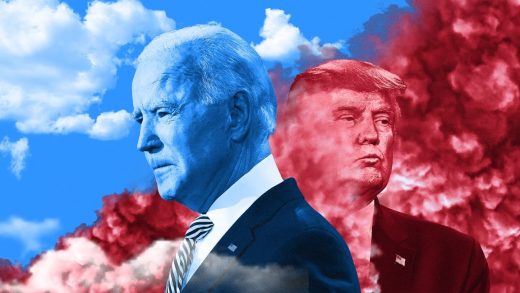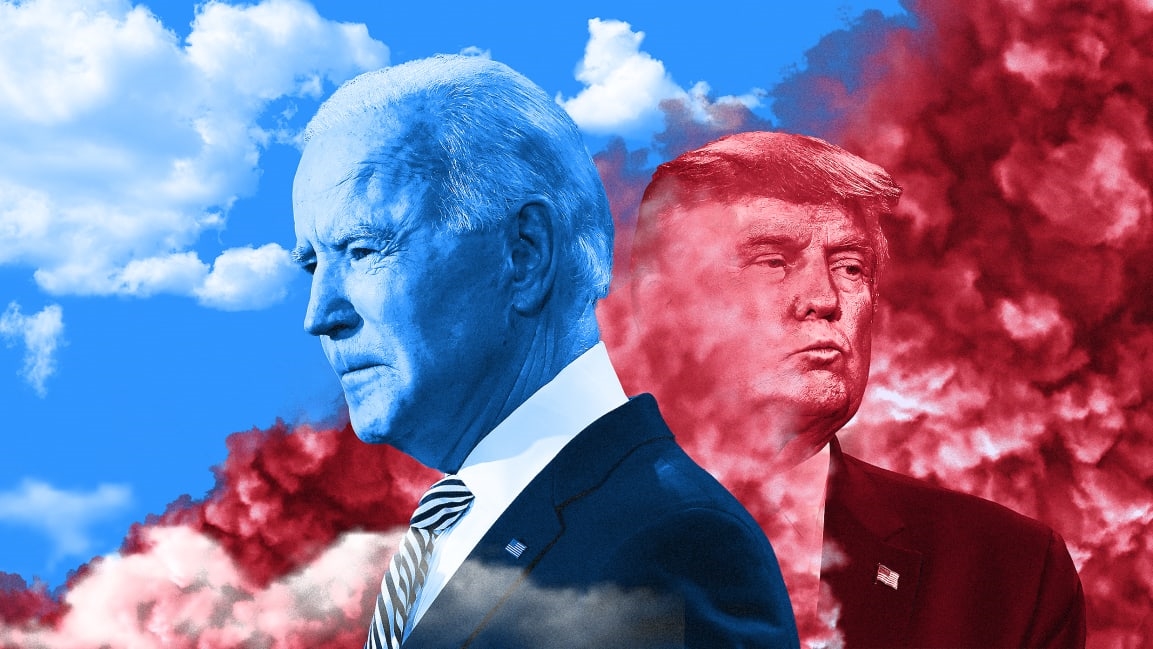The 2020 presidential election will decide the fate of the climate
Whether the world succeeds in avoiding the worst impacts of climate change is likely to hinge in part on the results of the upcoming U.S. election. Climate scientist Michael Mann has said that a second Trump term would be “game over” for the climate, making it virtually impossible to limit global warming to 1.5 degrees Celsius. Biden, by contrast, is proposing the most ambitious climate policy of any major party nominee in U.S. history. Here’s a closer look at the differences.
Trump: “It will start getting cooler”
The first major difference: Trump doesn’t accept the science of climate change or even necessarily seem to understand what “climate change” means. On a September visit to California, where heat and drought driven by climate change have helped fuel record-breaking fires, Trump said, “It will start getting cooler.” (He has previously called climate change a “con,” “hoax,” and claimed that it was invented by China.) At the first presidential debate, when asked about climate change, Trump started talking about clean air and water, and then claimed “we have now the lowest carbon.” (In fact, carbon dioxide levels in the atmosphere are now the highest that they have been in 15 million years.)
Through his first term, Trump has actively moved the country in the wrong direction on climate. “Across the board, the Trump administration has rolled or attempted to roll back all of the significant steps that the previous administration took under the Clean Air Act and other laws to reduce the carbon pollution and the other pollutants that are driving dangerous climate change,” says David Doniger, a senior advisor to the NRDC Action Fund, a political affiliate organization of the Natural Resources Defense Council.
The administration weakened fuel economy standards, eliminated the Clean Power Plan, and weakened standards for emissions from the oil and gas industry. “The auto industry didn’t ask for this,” Doniger says. “They asked for some relief, but they didn’t ask for what they got. The power industry didn’t ask for this. The oil and gas industry didn’t ask for this.” The only silver lining: The administration has been so incompetent that many of its environmental rollbacks haven’t succeeded. But Trump also withdrew from the Paris climate agreement, a withdrawal that will take effect the day after the election. (The U.S. could later rejoin.)
Trump’s campaign website says nothing about a plan for climate change. The Republican platform, recycled from 2016, says that climate change is “the triumph of extremism over common sense,” even though military experts have identified climate change as a national security threat and thousands of scientists have warned that we’re facing a climate emergency.
To actually tackle climate change, the federal government would need to do far more, and a second Trump term would delay that action as the window of opportunity is closing. “If the U.S. is out of the game, it’s hard to imagine a transition that’s fast enough,” says Leah Stokes, an environmental policy expert and professor at the University of California Santa Barbara. Even as other progress happens elsewhere—as in China, where Xi Jinping recently pledged to make the country carbon neutral by 2060—the world is unlikely to succeed without the U.S. For the U.S., a delay on climate action would also be a missed economic opportunity in industries like electric vehicles and renewable energy. “The innovation and technology opportunity is an opportunity for economic growth in this country, and job creation,” she says. “Ceding that global leadership is just crazy.”
Biden: The most ambitious climate policy of any major party nominee
Biden, by contrast, has proposed investing $2 trillion to set us “on an irreversible course to meet the ambitious climate progress that science demands,” with a target of net-zero emissions by 2050. By 2035, he wants to decarbonize the electric grid. “This is more ambitious than the most ambitious states in the country,” says Stokes. (California and Hawaii are aiming for 100% clean electricity by 2045; New York is aiming for 2040.)
The work on the electric grid would create millions of jobs. Retrofitting buildings to improve energy efficiency would create another million jobs. Ramping up the electric vehicle industry, and infrastructure like charging stations, would create a million more jobs. The plan also calls for “high-quality, zero-emissions” public transit for every large city, “climate-smart” agriculture, cleaning up pollution from the oil and gas industry, and the construction of 1.5 million sustainable homes and housing units. All of this would be done through the lens of environmental justice, ensuring that communities that have been hardest hit by pollution in the past see the benefits.
Though Biden has said that his plan is different from the Green New Deal, a resolution sponsored by Alexandria Ocasio-Cortez, the core principle is the same—creating jobs and fostering equity while reducing emissions. The Green New Deal wasn’t a specific plan, but called for broader reforms, including universal healthcare and providing every American with affordable housing. Biden’s plan is more narrowly focused on climate change. But Biden took input from climate activists behind the Green New Deal and made his plan more aggressive—boosting spending from $1.7 trillion to $2 trillion, speeding up the timeline for spending from 10 years to 4 years, committing to an earlier deadline for a transition to clean energy, and incorporating a larger focus on environmental justice.
“This is a very concrete vision to solving the problem on the timeline that scientists say is necessary,” Stokes says, adding that it’s more ambitious than anything that has come before. “We have never had a presidential candidate—not Barack Obama, not Hillary Clinton, not anybody—who has actually put forward a vision like this.” The scope of the plan has to be massive because the country has waited so long to act; the changes could have been much more gradual if we had started 25 years ago. “We’re in a tough spot now,” Doniger says. “If Biden is elected, there’s a need for very deep reductions very fast.” Still, the vast scope of work means creating millions of jobs at a moment when the country also needs to invest in economic recovery.
If Biden wins—and, crucially, if Democrats also control Congress—it’s possible that the world could still avoid the worst impacts of climate change while addressing the recovery. “We’re going to need a very big recovery package, probably a lot bigger than the one from 2009,” Doniger says. “There’s a huge opportunity to build into that infrastructure spending for the transition to clean energy and low emissions that we need, and to do it in a way that invests in communities that have been underserved and beset by pollution.”
(21)



